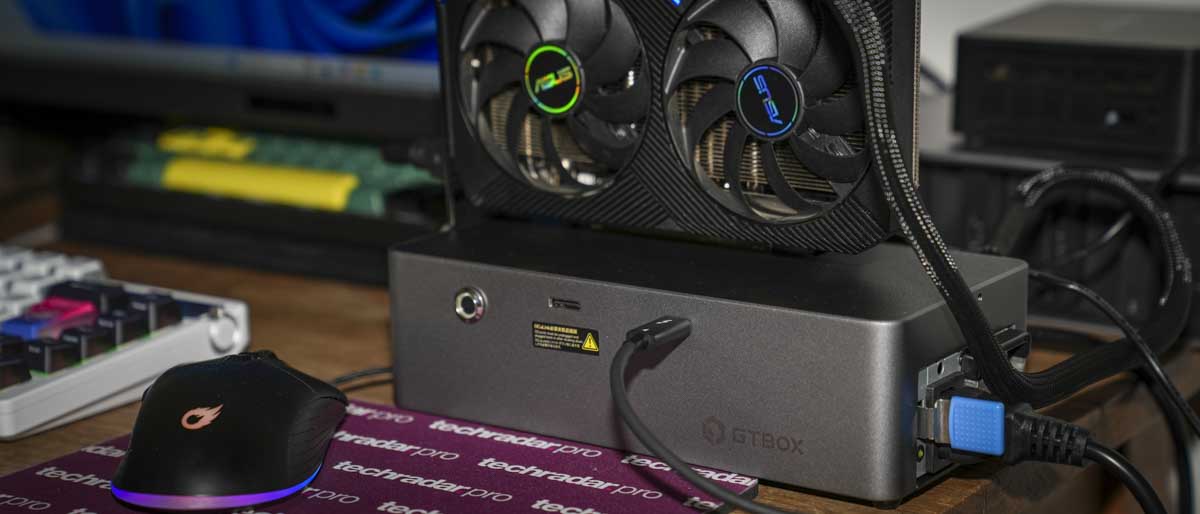TechRadar Verdict
The initial setup is easy, simply fit a desktop GPU, connect power, then link via USB4 or OCuLink. Windows 11 detects it almost instantly, and you're set to go. The industrial design isn't at all sleek, but its performance is excellent, instantly giving your graphics a huge boost.
Pros
- +
Easy installation
- +
OCuLink and USB4
- +
Test lab aesthetics
Cons
- -
Card and cables on show
- -
Some cards feel wobbly in the slot
Why you can trust TechRadar
GTBox G-Dock EGPU: 30-second review
Everything about the GTBox G-Dock EGPU looks like it should be a piece of equipment in a computer test lab. The design of the actual casing for the GPU is very simplistic, with an all-metal casing that looks like a workshop tool enclosure rather than a piece of high-tech computer equipment. However, the aesthetics are all part of what this EGPU is about, and the fact that it has an open design means that you can fit in any length of GPU you want, from the small ASUS Dual GeForce RTX 3060 V2 OC Edition with its dual fan design through to something more substantial such as the Asus ROG Astral GeForce RTX 5090 32GB GDDR7 OC Edition. This is the EGPU that has the room to fit all.
Set up and installation are quick and easy, with a card simply popping in on top, then a standard 8-pin power supply cable linking directly from the side of the GPU into the power slots of the card. All you need to do after that is plug in USB4 into your machine, or if you have the latest OCuLink on your mini PC or a laptop, then you can utilise that connector.
In this review, I've used the Geekom IT15 mini PC and its USB4 port to connect directly to the GTBox G-Dock EGPU, then used an Asus GeForce RTX 3060 Ti Dual OC Mini 8GB GDDR6 graphics card in the EGPU unit.
Performance across the board is boosted with the power of that GeForce RTX 3060 Ti. While a little bit older, it's still putting in a strong performance, with Adobe Photoshop, Lightroom, and Premiere Pro all seeing a significant uplift in processing power and speed.
Checking out the benchmark results and the increase in performance is obvious, and what's surprising is that, unlike some other EGPUs, it's really the GPU itself keeping cool. The system runs incredibly quietly.
One thing that I would say is that whilst the design of the EGPU is incredibly robust, the connection of the GPU into the top slot can feel a little bit wobbly, so it's best that the EGPU is positioned somewhere where it won't get knocked, despite having a large bolt to hold the GPU in place. Cable management is also a little bit messy, as they just hang free from the card, and there are no clamps or clips to keep them in position.
It's also worth pointing out that due to the Mac architecture, EGPU use will only work with PC systems, with Windows 11 or Linux, so if you're looking for a graphics boost for your Mac, unfortunately, at present, there's nothing that you can really do.
Sign up to the TechRadar Pro newsletter to get all the top news, opinion, features and guidance your business needs to succeed!
Otherwise, when it comes to overall performance, it's only limited by the GPU that you put into that slot, and as long as your laptop or mini PC is capable of accepting an EGPU, then running this should be incredibly easy.
GTBox G-Dock EGPU: Price and availability
- How much does it cost? £249 / $249
- When is it out? Now
- Where can you get it? Widely available
The GTBox G-Dock EGPU with OCuLink is available directly through the GTBOX website for $249/£249 just for the EGPU unit itself (you'll need to put in your own GPU for graphics processing). You can check it out by clicking here.
Right now, TechRadar Pro readers can get $10 off when using the code TECHRADAR10
It's also widely available on other major online retailers such as Amazon.
- Value: 5 / 5
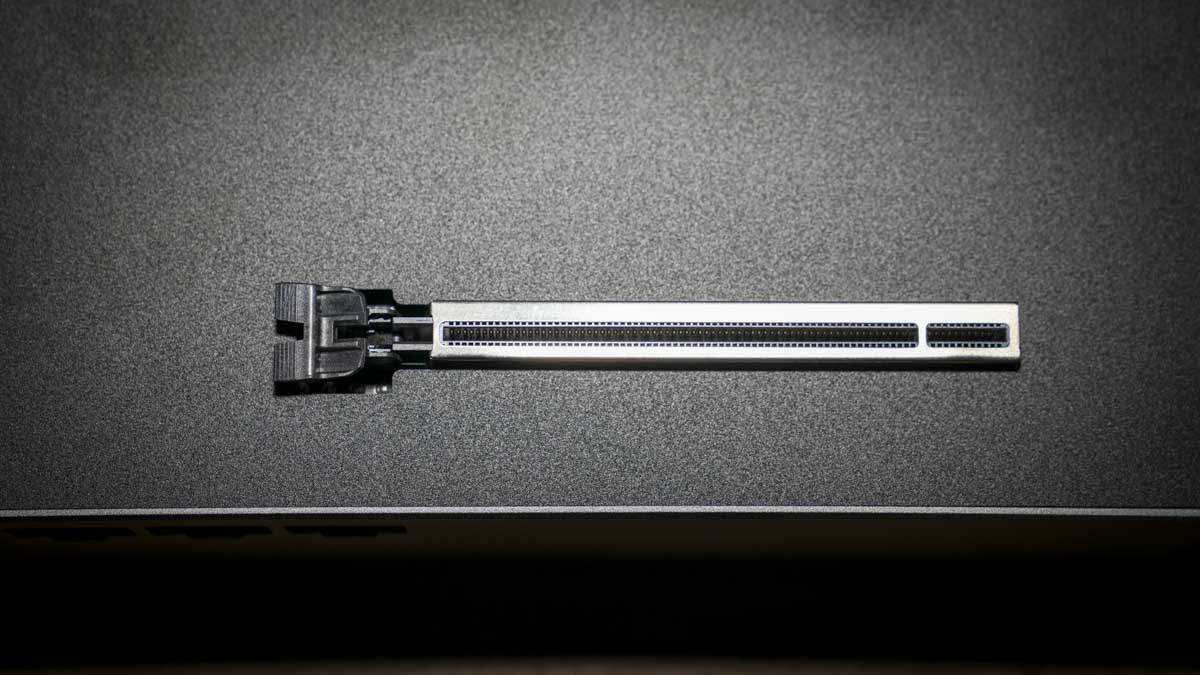
GTBOX G-DOCK EGPU docking station: Design
CPU: N/A
Graphics: External via user‑supplied GPU (PCIe x16)
RAM: N/A
Storage: N/A
Front Ports: 1 × OCuLink, 1 × USB4 (100 W PD)
Rear Ports: 3 × 8‑pin PCIe GPU power cables
Connectivity: PCIe 4.0 ×4 OCuLink (64 Gbps), USB4 (~40 Gbps)
Audio: N/A
Camera: N/A
Size: 22.5 × 11 × 6 cm
OS installed: Windows supported (11 22H2+)
Accessories: OCuLink cable, USB4 cable, 3 GPU power cables, switch cable, support bracket
In terms of aesthetics, this is a piece of kit that looks like it's been taken directly from an old test lab of the late '90s or early 2000s. The metal enclosure from the electronics gives it a sturdy build, and the fact that it has additional safety features such as the AC kettle lead clamp, a large red release lever next to the power lead, a silver push button power switch and a large securing bolt, which essentially clamps the EGPU in place, all reflect a product that could have been designed by IT technicians rather than a consumer piece of gear.
When it comes to size, it measures 225 × 110 × 60 mm and weighs 1.5 kg, not including the GPU that you pop on top, as this will both add to the weight and length of this EGPU.
However, whilst the aesthetics might not have the product design that we are used to with computer accessories these days, what it does enable is absolute flexibility when it comes to the size or scale of the GPU that you want to use. If you are swapping GPUs frequently, as I find myself doing quite often, then this type of unit is ideal as you don't have to dismantle anything in order to pop the GPU in, simply pop it in and plug it in, and you're ready to go.
The one issue that I found is that the card is only held in place by the PCIe slot and a clamp on the side of the unit rather than from the usual top clamping position that you would get in most PC cases and enclosures. This can lead to a little bit of wobble of the card within the slot, so it's absolutely essential that you put it somewhere where it isn't going to get knocked or bashed, as the card is fully exposed to the elements, fans, components and all.
Once in place, you can then plug in the power from the eGPU to the GPU, and this utilises a standard PCIe 8-pin cable. Then it's just a matter of plugging in the USB4 cable from the EGPU through to your computer or utilising the OCuLink option if your machine happens to have it.
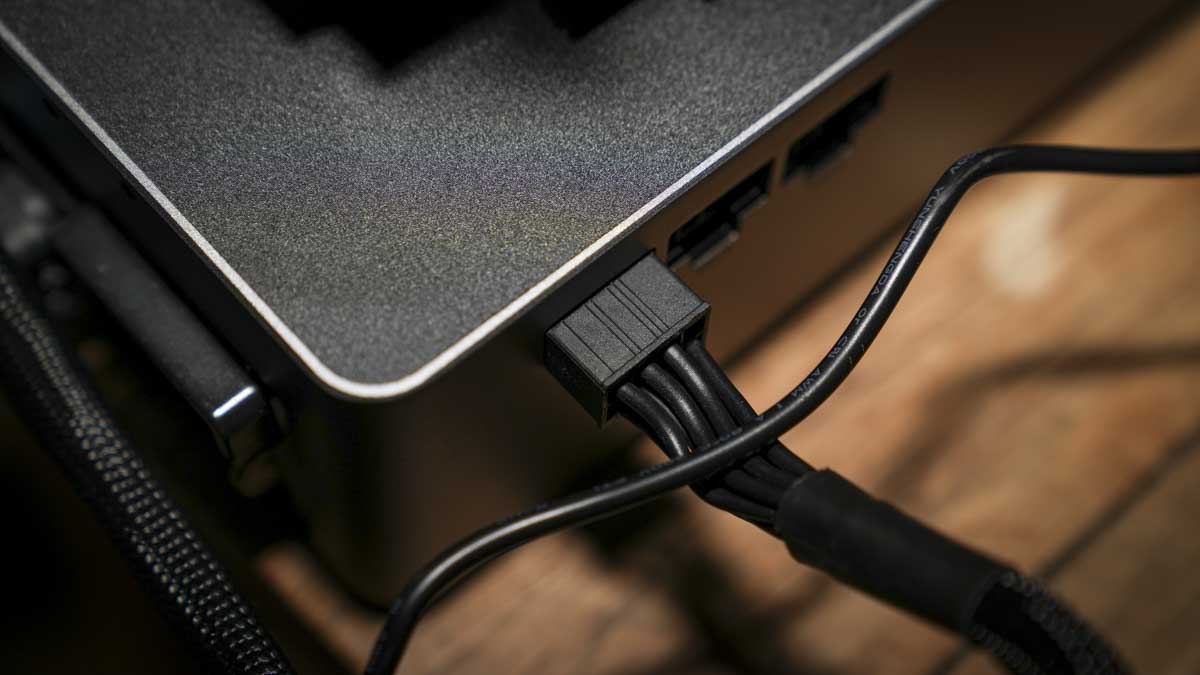
GTBox are keen to highlight a few things about the GPU. Since the introduction of the M chips from Apple, this EGPU, or any EGPUs for that matter, no longer works with the latest generation of MacBook Pros, Mac minis or Studio Macs. So, if you are looking for a graphics boost for your Apple Mac computer, then this isn't the solution. Likewise, computers with CPUs prior to the 7840U series might find a few compatibility issues. However, anything beyond the 7840U series and later, such as the 8840U, should find that this is fully compatible, so it's just worth checking before you go out and buy any GPU that your system can actually support.
Taking a quick look around the body of the GTBox, there's really very little to it. On top, you have the PCIe slot, and then on the front, you have the power button, OCuLink and USB port. On the side, you have the AC power input with a lever to stop you from accidentally removing the lead. Next to this is the fan, with a very DIY-style wire mesh guard over the top. On the back, you have three eight-pin power slots to fit directly into the card or other devices that you might want to link in.
- Design: 4 / 5
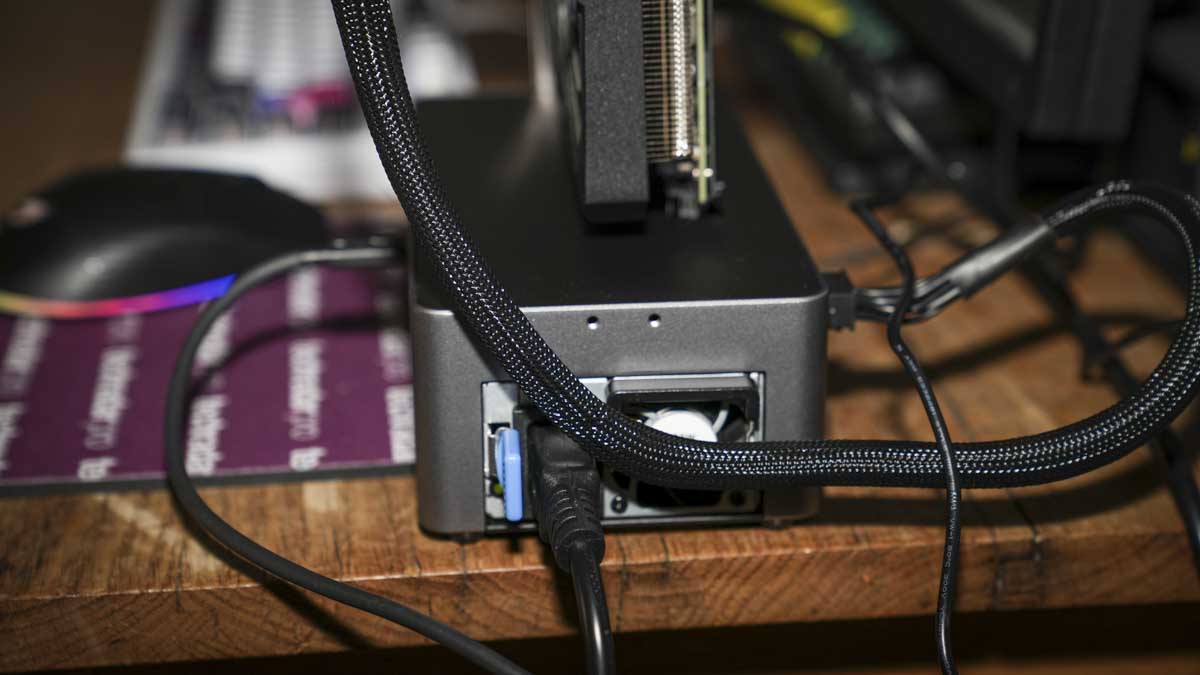
GTBox G-Dock EGPU: Features
One of the things I really like about the GTBox G-Dock is that it has been designed to be as basic and functional as possible. It might look like it's been built by a technician in a test lab, but actually it's quite refined, when it comes to design, use and functionality, it's just about as streamlined as you can get.
First and foremost, you have the solid metal body design with this aluminium profile mid-frame that ensures absolute durability, so if you are testing GPUs in an IT department, then this could be a perfect solution as it's very quick to install the GPU and remove it and pop in the next for testing. Likewise, if you're working in any type of environment where GPUs need to be quickly tested, then this EGPU is a superb option, with a simple pop-in and bolt-to-secure-in-place design.
Inside, powering the GTBox is a customised Huntkey 800 W power supply, which should provide plenty of power to the GPU but also acts as a power hub for other accessories that you might want to test or use at the same time. Think of it a little bit like an external power supply that you might have within a desktop PC.
Alongside the USB4 port for connecting directly to your computer, the system also features an OCuLink port that provides 64 GB/s of effective bandwidth for PCIe 4.0 ×4 lanes. It's worth pointing out that the dock is not hot-swappable when using the OCuLink port, which is just a common feature of this type. As OCuLink is the latest graphics port, it offers up to 7.13 GB/s; this compares with the already impressive USB4, which also offers 3.87 GB/s, so you have almost double the potential transfer rate of standard EGPUs, and it also offers huge flexibility.
When it comes to the main PCIe port on top, this is a PCIe x16 interface with a maximum power consumption of the graphic cards supported being set at 600 W, which essentially means you can use almost any graphics card on the market today.
When it comes to support, it works with most Windows 11 machines, but do check the compatibility as not all Windows 11 machines, even the latest, will support the use of the eGPU, and of course, it will work with Linux machines, but there'll be a little bit more work in order to ensure full compatibility.
Another feature about the dock is it offers USB4 reverse charging, so if you are using a laptop, then there's no need to hunt around for its power supply as that USB4 connection between the dock and your laptop will also provide power, giving it a much-needed charge as well as that graphics boost.
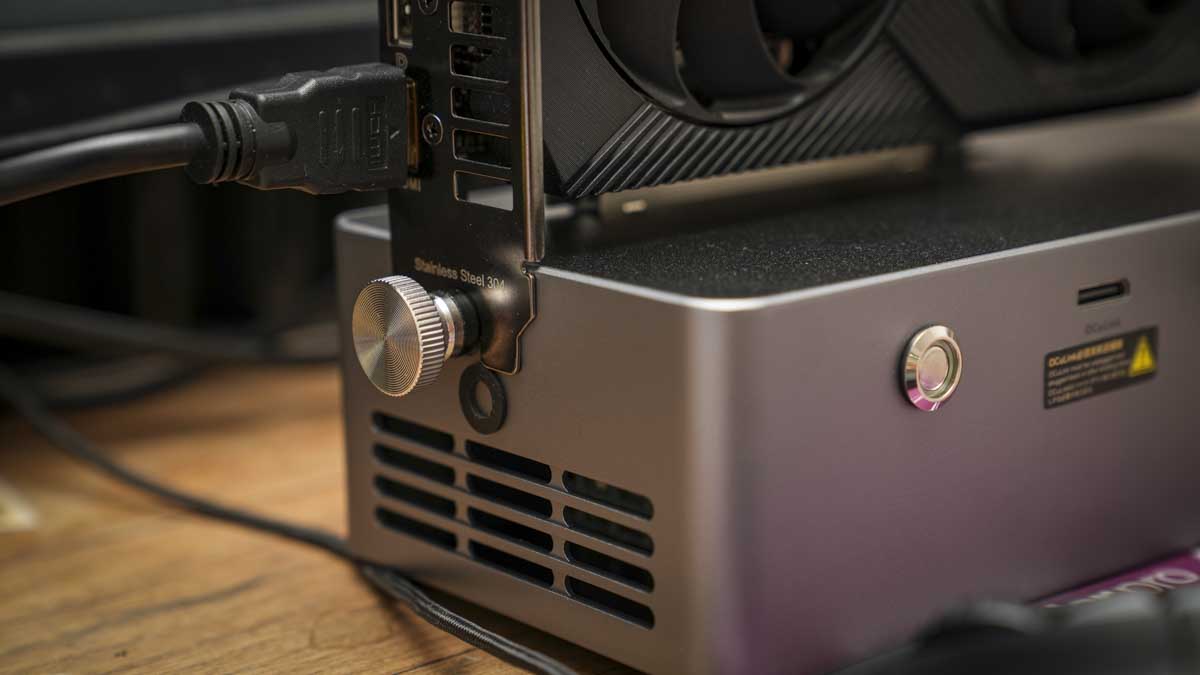
- Features: 4 / 5
GTBox G-Dock EGPU: Performance
Getting started with the GTBox G-Dock EGPU is exceptionally easy. I popped in the Asus GeForce RTX 3060 Ti Dual OC Mini 8GB GDDR6 into the PCIe x16 interface on top of the box, then using an 8-pin graphics card power connector, connected the card to one of the three eight-pin PCIe ports and finally used the large knob on the side to bolt the card securely in place. Once in place, there was a little bit of a wobble from the card itself, as essentially all of the fixings are on the base of the card rather than the top and bottom corners of the card as you would see on a standard PC case. If I were to use this long-term, then just for security, I'd probably create an additional clamp just to give it extra rigidity in the clamp, especially for larger cards; however, it all feels robust enough and as long as it's not going to get knocked, which it shouldn't do on your desktop, then it should be absolutely fine.
Once the card is set up in the EGPU, it's then just a case of plugging in the power. Here, interestingly, they've added a security safety lock onto the AC power input and use a standard kettle lead, but once inserted, it's securely clamped in, and you have to pull the lever back in order to remove that cable. It's a nice feature and helps avoid any issues with accidentally removing the power supply when in use.
With everything set and ready to go, it was just a case of linking the USB4 cable to the back USB4 port of the Geekom IT15 and then powering up as usual.
Without needing to download new drivers, Windows 11 Pro loaded without issue. While the Geekom IT15 is a powerful machine with plenty of processing power when it comes to graphics potential, the integrated graphics did let it down somewhat; however, with the power boost this EGPU gives, all applications run at an extra level of speed.
Creative applications Adobe Photoshop, Lightroom and Adobe Premiere Pro all saw a huge uplift in performance. Whilst it was by no means bad before, you can really see a difference, with longer edits made possible in Adobe Premiere Pro with render times and the application of effects being far faster and much better handled.
The real difference came when I started to look at some of the more demanding games, such as Indiana Jones and the Great Circle and Hogwarts Legacy. Both of these titles were playable before to a good level, but now the settings could be increased and the full potential of the games realised, although the only thing now limiting it was the slightly older Asus GeForce RTX 3060 Ti Dual OC Mini 8GB GDDR6 card. However, you definitely see an uplift in frame rates, ray tracing and effects within the games, giving a more immersive experience.
The other thing which is worth pointing out is that because all of that graphics processing is now happening on the exterior of the machine, things stay nice and quiet for the duration, and the big fans of the EGPU and the fact it's open to the elements did help to keep things cool and quiet.
At the end of the test, the benchmarking results highlighted just what degree of graphic performance boost the addition of this EGPU has given this small machine. It is, in essence, quite substantial, with the biggest benefit being seen for creative applications such as the Adobe suite, Photoshop, Lightroom and Premiere Pro, and, of course, where you would think that it would be most advantageous for gaming.
Mini PC | Header Cell - Column 1 | IT15 Results base | GTBOX G-DOCK |
|---|---|---|---|
3DMark | WildLife | 22,452 | 41,225 |
| Row 1 - Cell 0 | Fire Strike Overall | 7788 | 10,861 |
| Row 2 - Cell 0 | Fire Strike Graphics | 8452 | 11,088 |
| Row 3 - Cell 0 | Fire Strike Physics | 31,496 | 29,348 |
| Row 4 - Cell 0 | Fire Strike Combined | 2866 | 5184 |
| Row 5 - Cell 0 | Time Spy Overall | 4235 | 5653 |
| Row 6 - Cell 0 | Time Spy Graphics | 3808 | 5165 |
| Row 7 - Cell 0 | Time Spy CPU | 11,626 | 12,197 |
CineBench23 | Single | 2132 | 2176 |
| Row 9 - Cell 0 | Multi | 15,043 | 14,071 |
GeekBench | Single | 2984 | 3014 |
| Row 11 - Cell 0 | Multi | 14,981 | 14,948 |
| Row 12 - Cell 0 | Compute | 38136 | 42132 |
- Performance: 5 / 5
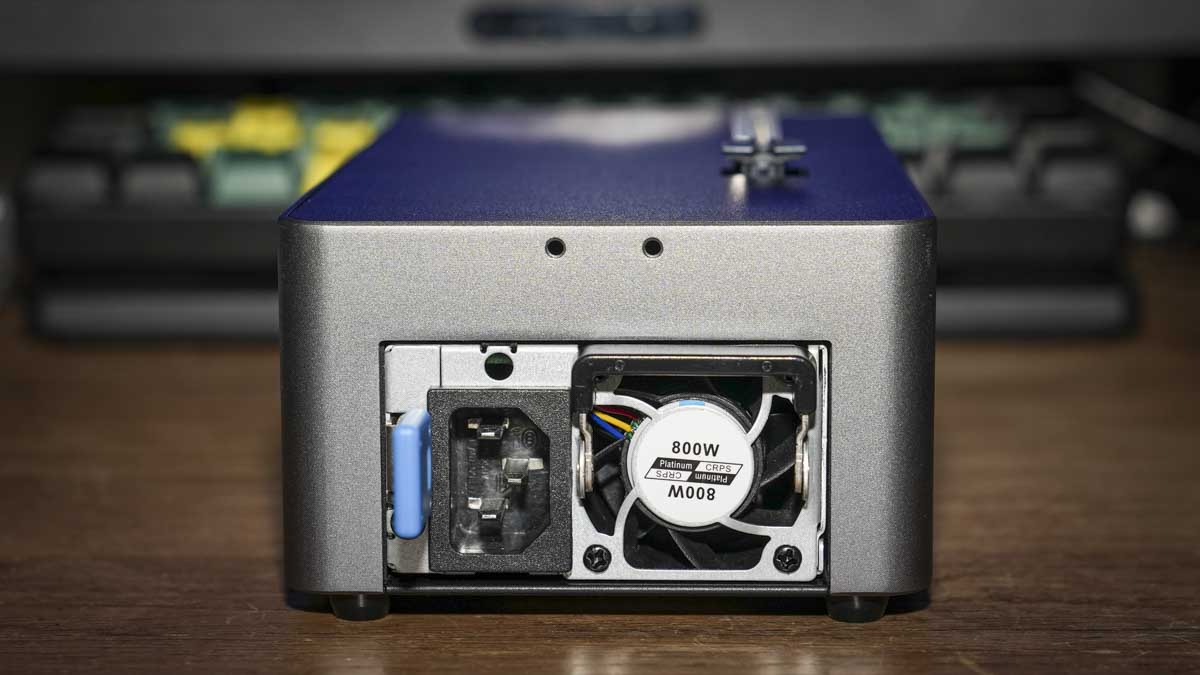
GTBox G-Dock EGPU: Final verdict
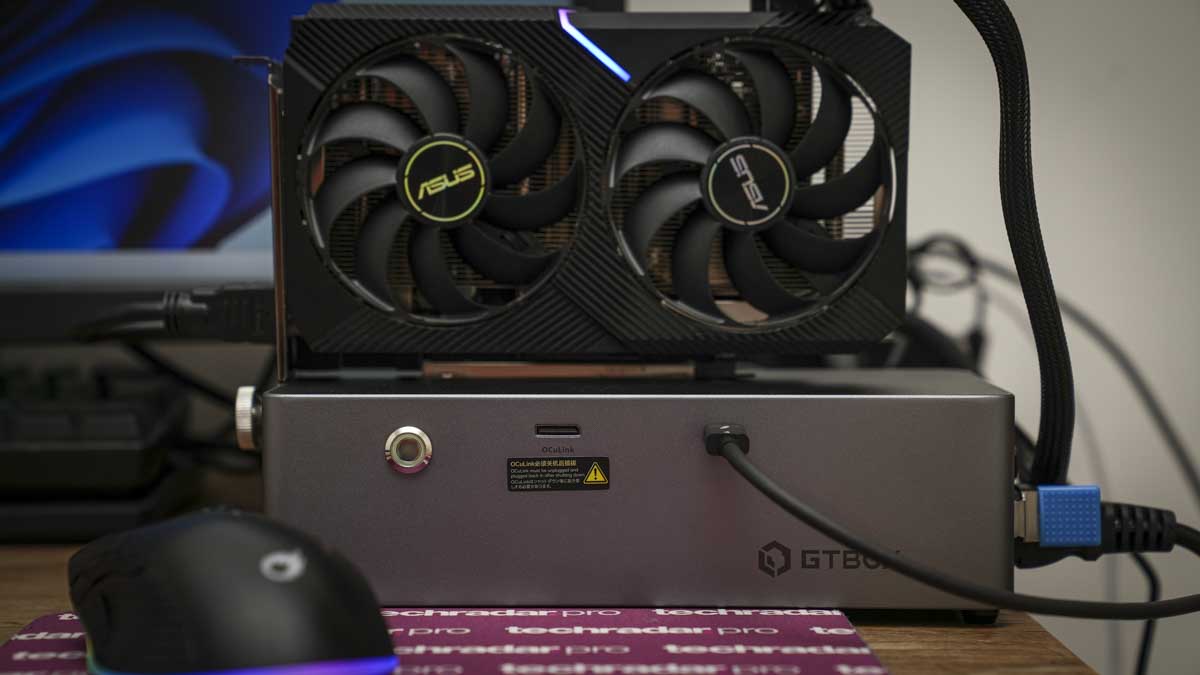
The GTBox G-Dock EGPU docking station is a specialist EGPU, and it won't suit most people. For general consumer use, you have the Razer Core X EGPUs, which are product designed to be easy to use and keep the GPU nicely contained within a metal box, away from prying fingers and potential damage.
The GTBox G-Dock EGPU is fully exposed and is better suited to people who like to have their expensive graphics cards on display or, more likely, in an IT department environment where GPUs need to be checked and tested. Or, if you are mining for Bitcoin, then again, having a dock like this might well be a good option. However, for the general user, leaving your graphics card exposed to the elements, where potentially it could get damaged, might not be the greatest idea. However, if you like that test bench look, then this is a superb option.
Should I buy a GTBox G-Dock EGPU docking station?
Value | Excellent value for money; you just have to consider that you also need to pay for a GPU | 5 |
Design | Stripping away the high-end product design and giving you something which looks like it's been designed by a technician definitely has disadvantages | 4 |
Features | With a pure focus on the performance of the GPU, features are highly tuned, and it doesn't deviate from its core use | 4 |
Performance | When it comes to the performance of the cards fitted, the power boost they gave to the host machines was vastly improved | 4.5 |
Overall | If you like the open design or you need to check multiple GPUs, then this is a superb option | 4 |
Buy it if...
You need an open EGPU.
If you need to test multiple GPUs, then this is a superb option, enabling you to fit and remove cards within a few seconds and offering plenty of flexibility over the length.
You like to see the inner workings.
Leaving consumer product design behind, if you like to see the electronics that you spent a fortune on, then this EGPU will leave your card directly on display.
Don't buy it if...
You like sleek aesthetics.
There's nothing consumer product designed about this unit, and it's more a test bench than a sleek tech apartment, with an aluminium casing and all electronics on show.
You need something portable.
This is an EGPU that needs to be left in situ with the graphics card attached. While you could transport it, it's reallydesigned to be used in one location.
For more solutions, we've reviewed the best laptop docking stations you can get right now.
Alastair is a photographer, filmmaker and tech writer who has been working in the publishing industry since the late 1990s. For more than 25 years he has covered photography, video and technology across Future's photography, technology and gaming brands. He runs a photography and video production company and lectures in TV and film. He can usually be found testing mini PCs or prototyping and prop building with the aid of 3D printing.
You must confirm your public display name before commenting
Please logout and then login again, you will then be prompted to enter your display name.
